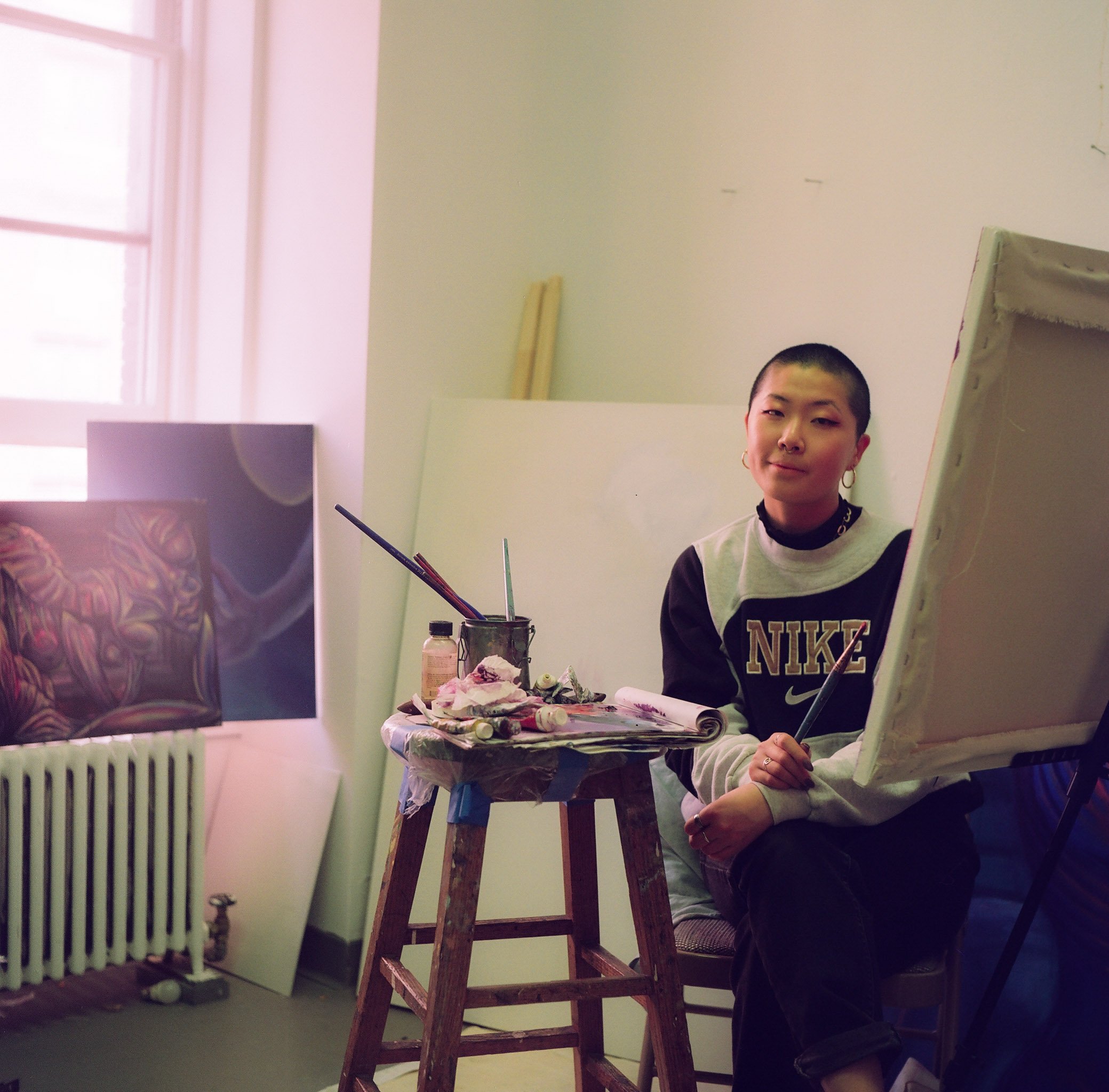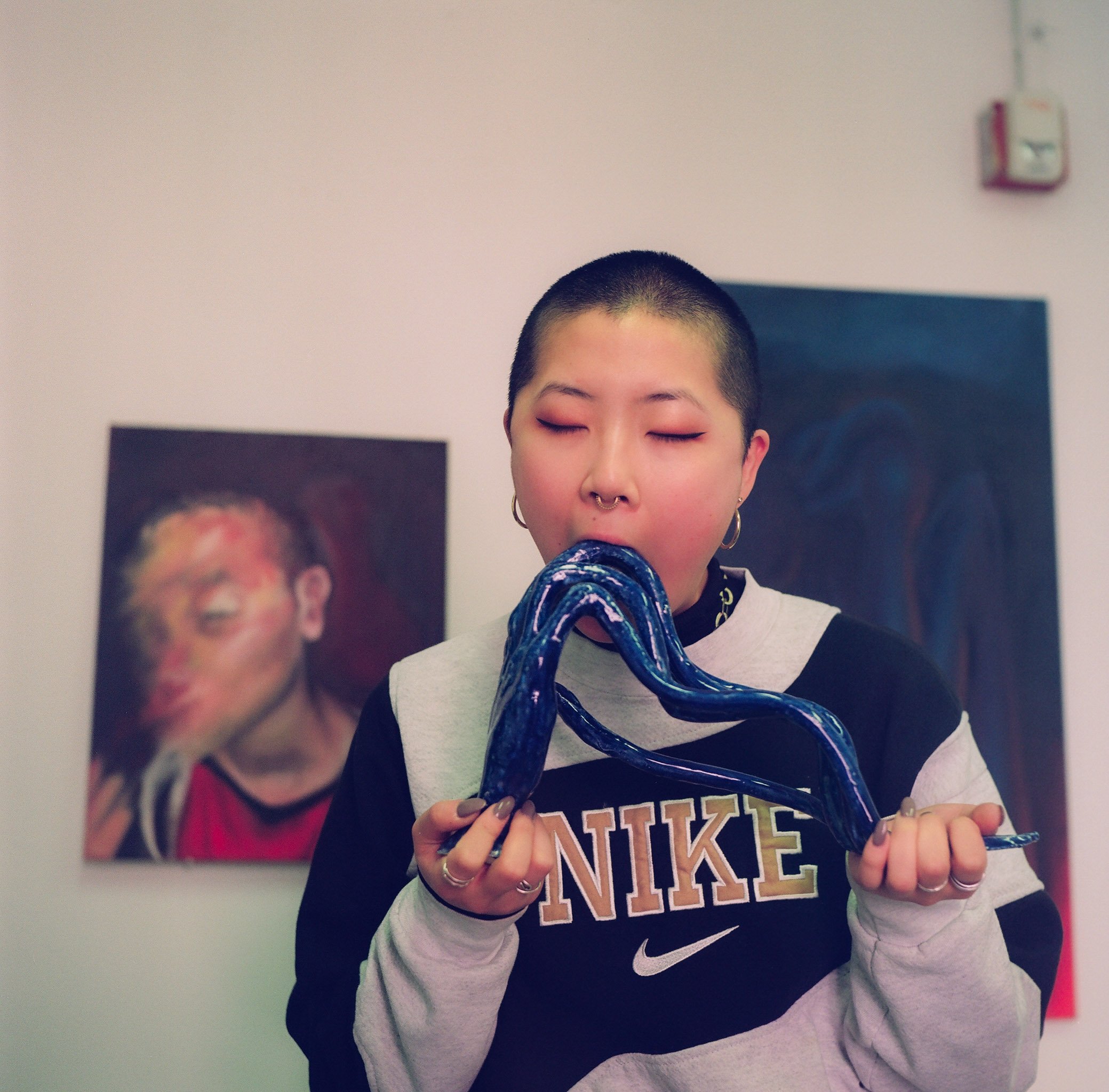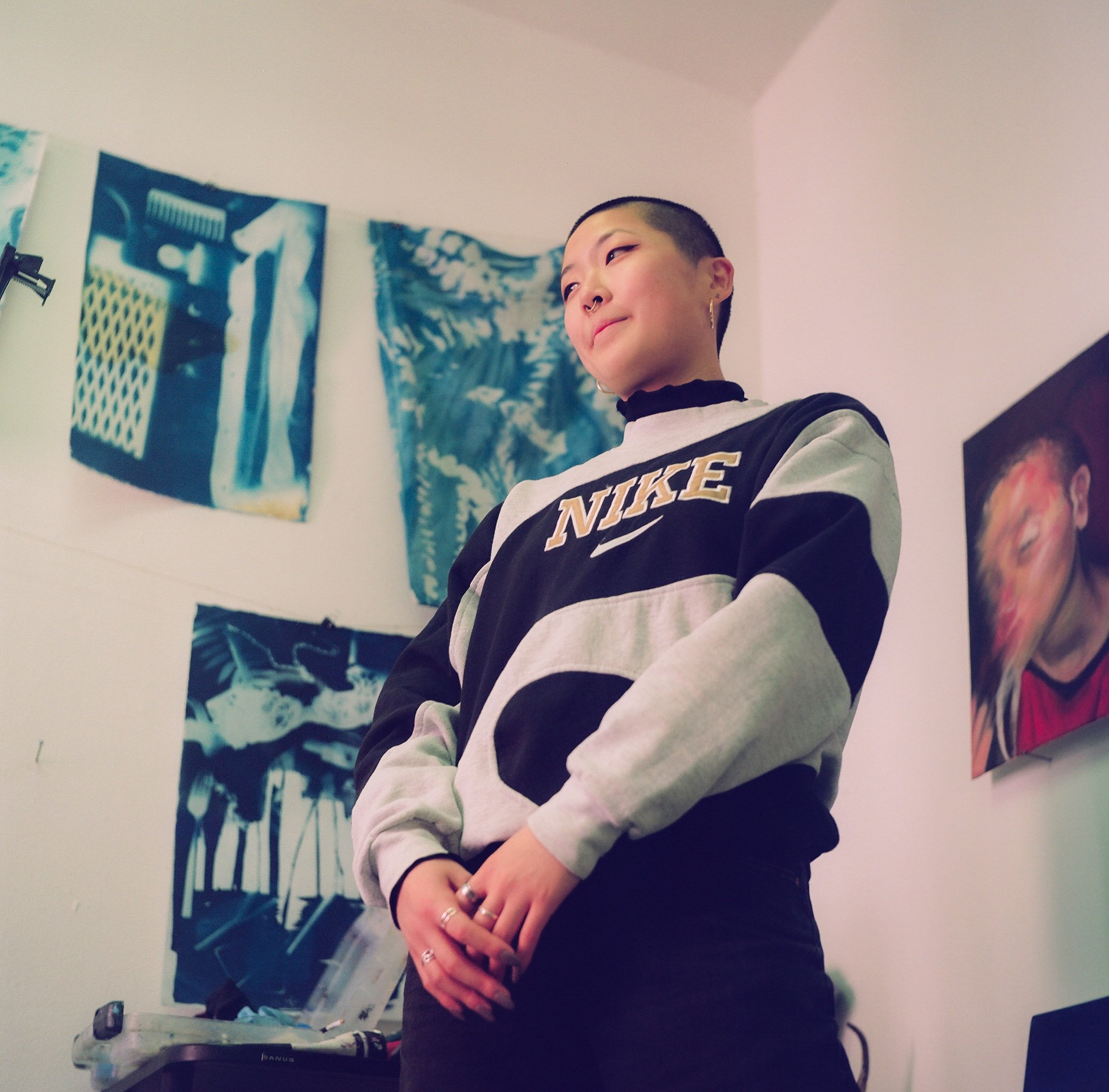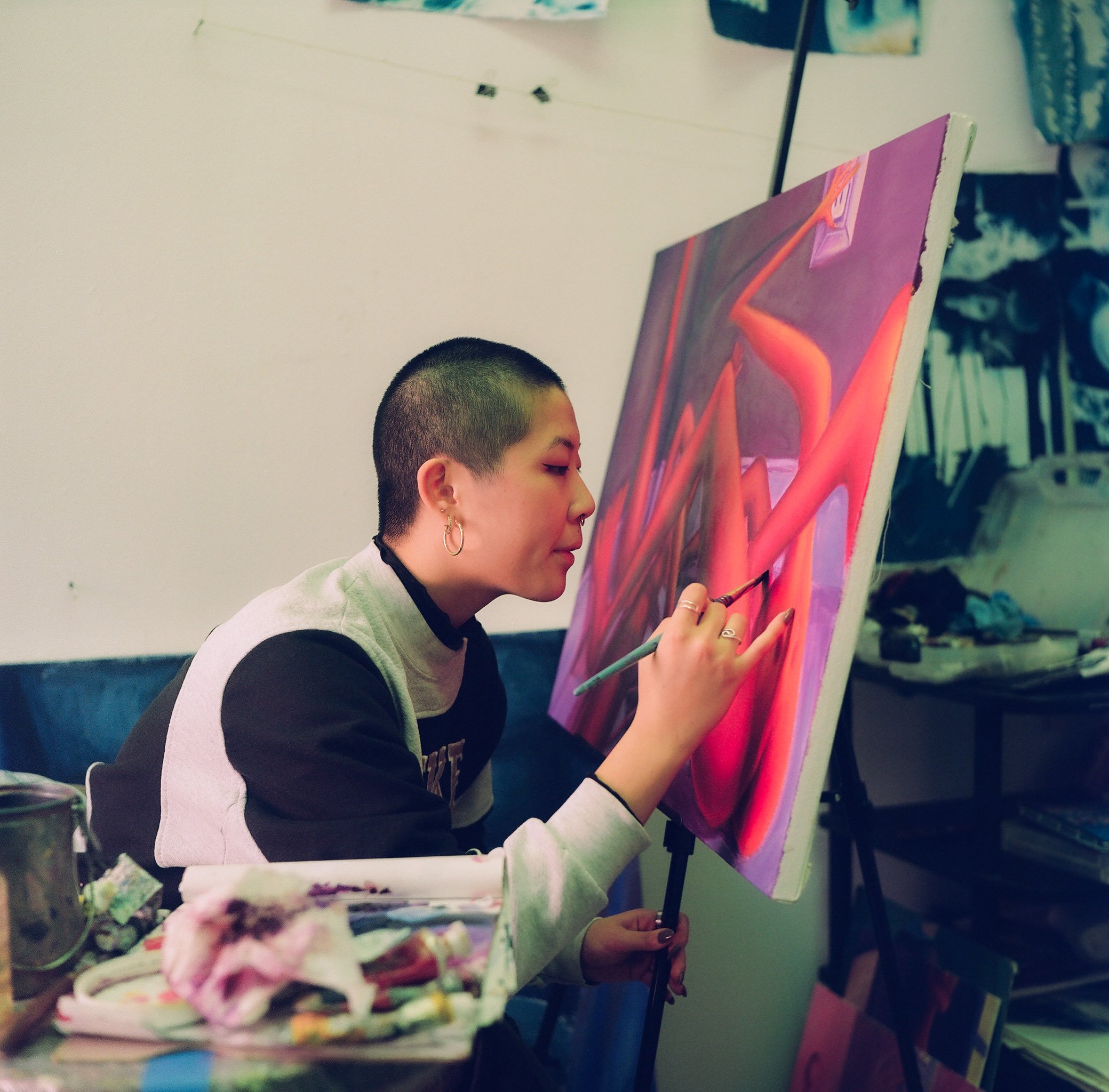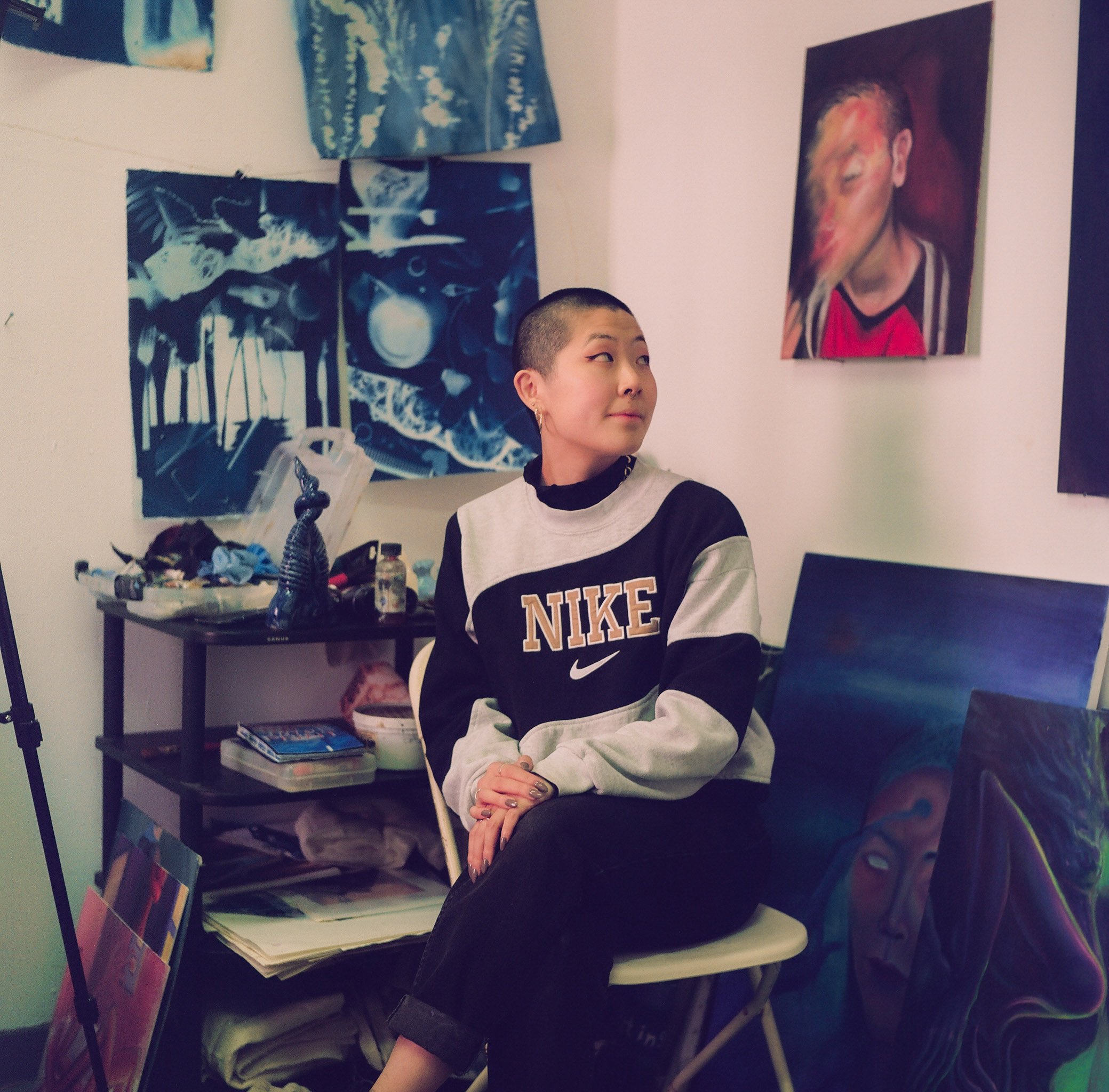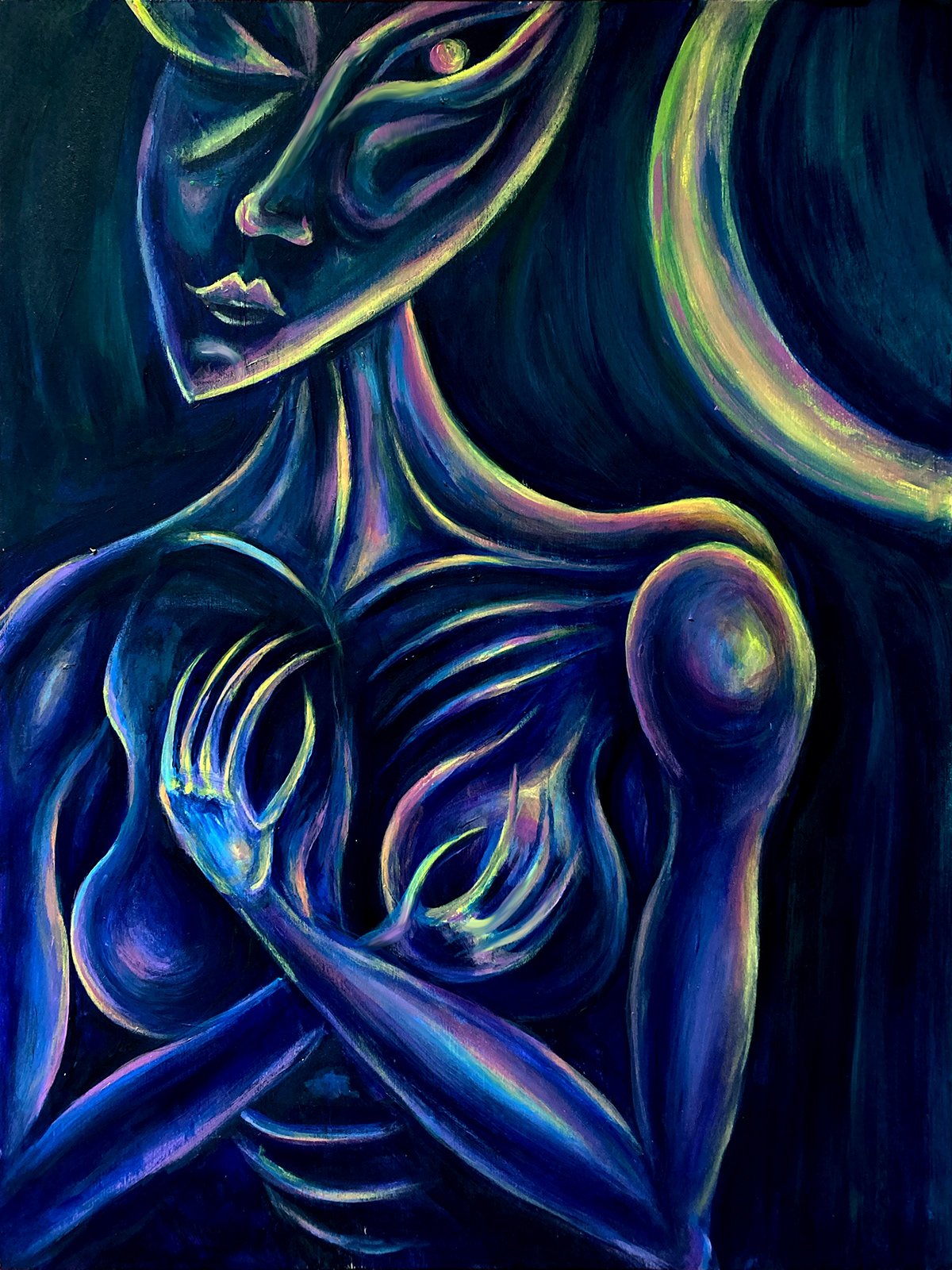Feature by Korrin Lee
Photos by August Cao
Cat Luo (they/she) is a senior in Columbia College majoring in Visual Arts and Creative Writing. Cat’s work traverses several mediums such as traditional painting, ceramic sculpture, and printmaking. Their work explores alienation and isolation as it relates to the femme queer body in uncanny yet uncomfortably familiar domestic spaces. Home is a concept for her, a psychological space, and their work aims to capture and recreate psychological spaces of distortion and absurdity. Shit gets weird as a second generation queer Asian American in the US and Cat hopes to find solace in being an alien, a foreigner, in environments that are meant to be familiar or comforting.
How does your vision affect your work? Does it affect how you see color and conceptualize contrast and composition?
I remember being in these art classes and my teachers asked, “Why do you make these stylistic choices? Why do you have such high contrast? Why do you choose such bright colors? And why do you have fingers with super smooth skin?” and at the time I didn’t know why. Thinking more about it, I do have a history of visual impairment; I was born with congenital cataracts and so my vision is 20/30 or 20/40 with contacts– but without them I am legally blind. Which is pretty cute. Very blurry. Because of that, the few things that end up catching the attention of my very overstimulated eyes are really shiny or hard-to-miss.
I really love architecture, and a professor once said that my paintings are very sculptural. The way that this manifests in my art is with the sharp transitions, sharp edges, contrast, really stark colors that catch your attention. The way this translates to my ceramic work makes a lot of sense—I’ve always imagined painting as touching the edge of something. It’s a very flowy kind of movement. And I found myself thinking, why don’t I just go to clay? Clay is literally making it and it’s really satisfying. It’s ASMR for my eyes that work too hard during the day.
Korrin Lee: Our eyes work way too hard actually. Everything is so overstimulating all the time!!
When I was looking at your art, I felt like there was a sense of entanglement in some of your work—more like self-entanglement, like the body is running into itself. Would you say that’s a theme in your work? Does it translate in any way to your recent ceramic work?
Cat Luo: Entanglement isn’t a term I’ve thought about but it makes a lot of sense. Ironically, as an artist a lot of people in my family see me as this hyper-individualistic person, but how am I supposed to understand other people without understanding myself? I’ve always tried to understand what the hell is going on in my brain and how I fit into the meatbag avatar that is my body. I think that forever self questioning or self entanglement is something that I am working through in my art but I don't think there's an answer or end to it. It is forever fun to stare in the mirror and be like Who am i? To always question your identity.
I think it’s a lot easier in my current body of work to express this sentiment because a lot of it is these distorted figures—a leg going into a torso, the torso turning into an arm and this sense of being lost and confused with yourself. All of these paintings and ceramic pieces are posed very intentionally by me; there’s almost an acceptance or meditation of this self-entanglement and being forever twisted up within myself, this messy ball of limbs that is kind of pretty and that’s how it’s gonna be forever until I smash it or something
K: You’ve said before that the body feels very alien. I feel like a lot of the bodies that are represented in your work appear to be very different than what viewers might expect - especially given clay is your medium of choice. That also ties in to your earlier mention of how malleability is so important when working with clay – so how does that idea of malleability apply to your depictions of the body across all your mediums? Is the body something that you see as a playground?
DreamGirlX
C: This painting [pictured above, DreamGirlX] I had a lot of fun with, it’s very different from some of my other work that is very close to the human body. At the time I was obsessed with ribs and I wanted to make their waist so skinny that it's insect-like. There's something playful about it, but oftentimes, I feel like I'm wrestling with a piece because I just take so much care to make these perfect curves.
On the theme of alienation, I think the term ‘alien’ itself is crazy, like how in legal documents anyone who is not a US citizen is an alien. I’m not from outer space! I’m not going to eat you I promise!!
I grew up in a very white area and a lot of that experience was characterized by me wondering, you know, why are people looking at me weird? Growing up I thought something was wrong or different about me and just felt like a big sore thumb– sticking out in a way I can’t quite explain. My work is an exaggeration of these feelings, of being both scrutinized and not seeing why, which are encapsulated in alienation, which then talks to isolation. It seems like everyone is scared of being lonely, which I find funny because my paintings are almost exclusively one figure. Because these are posed and because I enjoy painting these figures so much, there has to be a sort of joy in sitting in all of these complicated feelings by yourself.
K: Right? If you can't sit with conflict, then I don't know what you're gonna do with your entire life. I really like that idea of sitting with confusion because there are always going to be contradictions within yourself, so much to work through. The way I’m visualizing it is like a rope course that you’re trapped in, trying to untangle the knots but it takes a while, so you get comfortable.
Bra Window
I think you have already touched on this with your comments on alienation and isolation, but what would you say your muse is? Or rather, what would be a motivating force behind your work? From the sense you have given me, I think it has a lot to do with the self, entanglement, etc?
C: We’ve talked about the body and self-entanglement, and I think gender is also a big part of that. Sometimes there's no actual signifier that these figures are femme, but that identity seems to be projected on my art often. A lot of my paintings are a redefinition of what femininity and the queer identity are, both personally and publicly.
I wasn’t very feminine growing up. I mean, now, I don't even have hair. I don't think most of these people in my paintings have hair either. Because I think long hair is a signifier of femininity, and I kind of hate that, because it's so arbitrary and hard to take care of–-why would I put in this work for something that doesn’t represent me in any way or bring me joy?
In my own representations of femininity, gender being a performance is very important. Presenting your art is a performance, and recently I was meditating on that and my paintings, which are all very posed. They’re all looking at you and not in a way that makes you feel comfortable. There’s something very powerful about knowing you’re being viewed and handling that viewership as someone who is femme.
Moonlady
K: My mind goes to a conversation I had this summer (it will connect, don’t worry) about the feminization of translation; often a translated work is seen as unfaithful to the original, you know, like it’s missing something that the translator cannot capture, there’s a degree of distrust there. So, the original work is seen as more authentic and the translated work is inferior. Thinking about this in terms of art, I feel as though certain techniques and color palettes are also feminized inadvertently because they are seen as being tied to a translated version of reality. Because of the bright color palette you use, and your tendency to portray these more “feminine”, alien, surreal and vibrant landscapes, Do you think these ideas have any affect on your art and how it's perceived?
C: I really dislike when people describe my art as sci-fi or fantasy because that’s not what it is. I also think that a more earthy, modernist color palette is taken more seriously, it’s very “masculine” or real or gritty, as opposed to more vibrant colors which I feel are seen as childish, but that’s what excites me. I do often feel like my color palette is not taken seriously.
It’s a bit funny because I feel like usually people who paint really bright colors are from warmer areas. I’m thinking of Carlos Sanchez-Tata who is from Venezuela, where it’s warm and beautiful with so much greenery and wildlife. And then me, I grew up in the suburbs and I’ve come to imagine this luscious kind of space where a different sort of life could exist that is not foggy sad suburbia. I feel like there’s something very extreme about my art, but also life is hard, so I’m going to have extreme fun in my paintings
[ K: Right, like why limit yourself to boring realism? ]
Concerning the body, I used to do a lot of portraiture with the traditional portrait set up (with bright colors of course) and I’ve started to move away from that because I think once you invoke such a specificity of someone's face, someone's identity, there's less freedom for me to be talking about these abstract things. Even in my bigger paintings, I've been moving away from faces or obscuring faces in a way where I feel I have more freedom to express more universal feelings, like alienation and isolation. You're not distracted by trying to identify who this is. drawing faces.
K: Yeah, I feel the alien aspect takes away the first part of figuring out what you’re seeing; whenever you see someone’s face your brain wants to categorize them, but these alien figures are beyond categorization, they’re not something that can be shown in real life, it just lives in your brain
By the Fire Pit
How do you think your identity as a queer, second-generation, asian-american person manifests in your work? In what ways do you want your identity to be articulated in your work?
C: One anecdote I want to share in this interview was that last semester in senior thesis, you have to write an artist statement. And mine was, “I want to make Asian American queer art” and that's how most people talk about their identity and art, but I think it's weird to tokenize or label yourself in such a way.
It is really hard for me specifically to portray the Asian American identity because– what am I going to do? A lot of the Asian American artists that I love, like Sasha Gordon and Amanda Ba, the only way their art is read as Asian American is because they do self portraiture.
I had a teacher who said to me “your art is Asian-American and queer, but it doesn't come across to me” and I thought, "You're an old white lady. Of course, you’re not gonna understand”.
But I feel other people can see my work and resonate with it, or at least see how it came to be out of a marginalized experience. And I think that's enough for me. It's impossible to not have my Asian American experience bleed into my work–it's already there. So I'm not gonna argue with my professor anymore about that. That was annoying; I'm not trying to serve my identity on a platter. Thinking about who my art is for, it’s for me primarily, and people who share my experiences.
[K: In my experience, going to this school means constantly being gaslighted by the institution about your identity and ideas, and it sucks really bad and no one tells you.]
And with my work, I’m not painting my face so there’s no way to really know—and I realized that I don’t want to be so in your face about it. I’m trying to express the experience of being queer and Asian-American, you know, the psychological spaces where everything is a bit absurd. And then there’s also the theme of alienation, like not belonging but at the same time, I have to build a home in my body, I have to get comfortable with being an alien.































